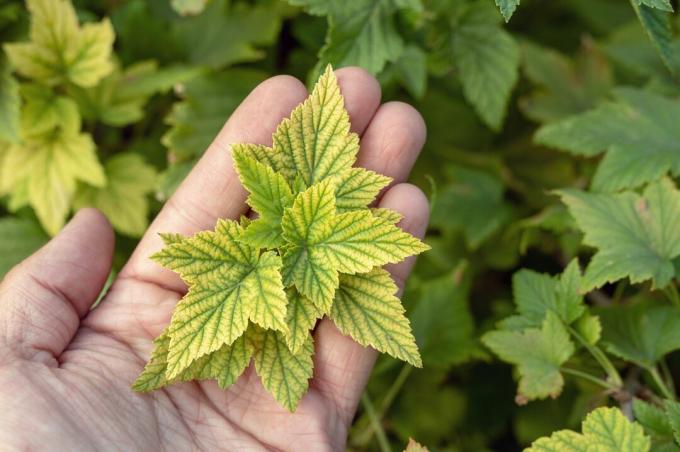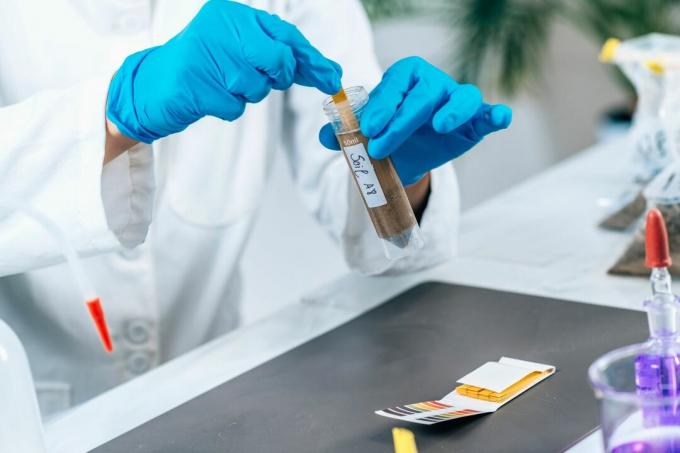Yellow leaves on plants indicate an iron deficiency. Under the so-called Hydrangeas, roses and rhododendrons are particularly common with chlorosis.

Chlorosis, also known as bleaching, is a common phenomenon in plants such as azaleas and hydrangeas. But what actually happens with this disease? Chlorosis is basically a deficiency in the green pigment chlorophyll. However, this dye is essential for the survival of every plant, as it is used to capture the energy of the sun's rays. Therefore, chlorosis should always be treated. The causes of the disease could hardly be more diverse. However, the same triggers for leaf disease are often found in our region. Here you can find out why some plants can be more severely affected by chlorosis and how you can get the problem under control in the short and long term.
contents
- Recognize chlorosis
- Species of chlorosis
- Prevent chlorosis and iron deficiency
- Chlorosis and Illness: Treat and Combat
Recognize chlorosis
Identifying chlorosis is child's play! If a leaf does not contain enough of the green pigment chlorophyll, it appears yellow or sometimes red in autumn. But chlorosis doesn't always have to be a bad sign. Perennial plants break down their chlorophyll in autumn and store the nutrients they have regained for the next season. Even in annual plants, chlorosis doesn't have to be bad. Especially old leaves that are shaded by many new leaves are superfluous ballast for a plant. The chlorophyll is also broken down in these leaves and the leaves turn yellow and eventually fall off. If the leaf yellowing gets out of hand or new leaves are affected, then it is a harmful chlorosis. If the cause is not addressed, the yellow leaves can die off after a while. In our soils, the cause is often an iron deficiency, but a nitrogen deficiency also often leads to the dreaded bleaching. If one of these two nutrients is missing, chlorophyll can no longer be produced. Of course, chlorosis can also develop when other nutritional elements such as boron or magnesium are missing, but such a case rarely occurs.

Species of chlorosis
Unfortunately, not all chlorosis is created equal. There are different forms of leaf disease, such as peak chlorosis or surface chlorosis. Despite the different chloroses, it is difficult, even for experts, to always correctly identify the cause. For this reason, we limit ourselves to leaf yellowing that is easy to distinguish. If chlorosis occurs first in the younger leaves, then iron is usually missing. However, if the old leaves turn yellow first, that is a sure sign of nitrogen deficiency. In rare cases, the chloroses appear like a mosaic on the leaves. Then it is almost certainly a virus that has infected the plant. Unfortunately, only varieties that are resistant to plant viruses can help. Direct control is not possible. As you may have noticed while reading the text, the most common cause of chlorosis is a lack of nutrients. However, so-called bad weather chlorosis can also occur. This is because certain weather conditions prevent the roots from absorbing nutrients. Persistent drought can lead to leaf chlorosis, as the roots cannot absorb nutrients such as magnesium and nitrogen without water. However, permanent waterlogging and cold soil are just as bad. Especially with the nutrient iron, dripping wet roots lead to reduced iron absorption and thus to chlorosis. This is especially true for wine.

Prevent chlorosis and iron deficiency
Since in Germany the reason for chlorosis is often an iron deficiency, we are particularly dedicated to this topic. Incidentally, in very few cases is there a real iron deficiency. Rather, certain circumstances mean that plants cannot absorb the iron present. The pH value in the soil has the greatest influence here. If the value rises above 6.5, less and less iron is absorbed by the plant. PH values below 6, on the other hand, promote iron absorption and must therefore be aimed for in the case of chlorosis. For this reason, if you have chlorosis, you should first measure the pH of the soil. If the suspicion that the soil is too alkaline is confirmed, it helps Epsom salt or Peat gifts. When using Epsom salt, it is imperative that the quantities specified by the manufacturer are adhered to, and when peat is used, it must be free of lime. However, it is not the case that all plants with a pH value above 6.5 suffer from chlorosis. This is because plants have to become active themselves in order to absorb iron. They give off organic acids via the roots and thus take up more iron. Some plants like citrus and rhododendron just aren't as good at this as other plants. Incidentally, even varieties of a plant species can differ greatly in terms of iron absorption. If you have major problems with chlorosis, other preventive and long-term measures can be taken in addition to changing the pH value:
- Regular watering when it is dry (it is essential to moisten the entire root ball)
- Lime additions worsen iron absorption (very hard tap water is also bad)
- If the soil is waterlogged, work compost into the soil, so that the roots are better supplied with air
- Iron deficiency is more likely to occur in purchased substrates, natural soil usually has a rich iron supply

Chlorosis and Illness: Treat and Combat
Fighting chlorosis is not that difficult. If you have already been able to rule out that the pH value is to blame for the bleaching problem, there may really be an iron deficiency. This often happens when growing tomatoes and roses in pots. It is rather irrelevant which nutrient is really responsible for the chlorosis. Because most of the time, the lack of nutrients is compensated for with a fertilizer that contains all the important nutrients. When choosing a fertilizer, however, you shouldn't just look at the price. Cheap supermarket fertilizers usually only contain the most important nutrients such as nitrogen, phosphate and potassium. Make sure that the fertilizer also contains all so-called micronutrients, including: iron, manganese, copper, zinc, boron and molybdenum. In addition to the essential trace elements, a good fertilizer also contains a very specific form of iron, the chelate. A chelate envelops the iron molecules in the soil, so the plants can absorb the iron much better. Incidentally, this mechanism was taken from nature. Sweet grasses such as wheat, maize and rice can themselves form so-called chelators in their roots. As a result, these plants often have fewer problems with iron deficiency. Foliar fertilization is a particularly quick solution to tackling chlorosis. Through the foliar fertilization, the nutrients are absorbed directly and can be used. But be careful: Iron with chelate must not be used when fertilizing the leaves, as it can damage the leaves. Therefore, it is better to use special foliar fertilizers. Please do not despair if the already yellow leaves fall off or die off. Unfortunately, chlorosis cannot always be reversed. But as long as the new leaves are lush green, everything is in the proverbial green area.
The following products have proven themselves in our garden:
- Rose fertilizer: HHigh quality special long-term fertilizerthat the leaf green through 2% magnesium oxide and iron supports.
- Tomato fertilizer: high quality special long-term fertilizer, the for tasty, healthy fruits and a rich harvest cares.
Like you specifically Identifying and treating chlorosis in geraniums you can find out in our special article.
